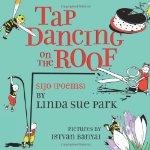Through the Looking Glass Children's Book Reviews
Tap Dancing on the Roof: Sijo (Poems)
Poetry Picture Book
For ages 7 to 9
Clarion Books, 2007 ISBN: 978-0618234837
Poetry comes in many forms, and these days, people are not only writing poetry in English using western poetry forms, but they are also experimenting with forms that are Asian in origin. Many of us have read or even written haiku, a form of poetry that originated in Japan, but not many people know about sijo, which is a Korean form of poetry. Like haiku, sijo poems are written “using a syllabic structure.” In English these Korean poems have three lines with fourteen to sixteen syllables. Sometimes the lines become so long that they have to broken up, and the poem ends up with six lines instead of three.
In each of the poems in this book, writer Linda Sue Park follows the traditional sijo pattern so that the first line of the poem “introduces the topic.” The second explores the topic a bit more, and the third wraps things up with “some kind of twist.”
The collection begins with a poem about breakfast, that first meal of the day that varies greatly, depending on the personality of the person consuming it. For some people breakfast is “Bagel and juice,” while for others it is simpler, and toast and coffee are the norm. Of course, there are some who would forgo an eaten breakfast all together in favor of “a few extra minutes in bed.”
In the poem titled “October,” the author paints a delightful autumnal picture of the wind playing with leaves. The gusts rearrange the leaves according to its whim. Then there is a clever shift, and the wind “plays tag with a plastic bag” and tugs at the narrator’s hair.
The topics explored in these poems are ones readers of all ages can respond to. Many of them are familiar situations and things that we encounter in our everyday lives. The author looks at pockets, echoes, frogs, a summer storm, tennis, laundry, bedtime snacks, brushing teeth and more. In each case, she takes a commonplace topic, and she turns it into something special. Sometimes the overall feel of the poem is contemplative and thoughtful, and sometimes it is amusing and surprising.
At the back of the book, the author provides her readers with further information about sijo peoms, the history of this poetry form, and “Some tips for writing your own sijo.”




